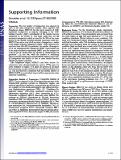Please use this identifier to cite or link to this item:
http://hdl.handle.net/10261/15628Share/Export:
 SHARE SHARE
 CORE
BASE CORE
BASE
|
|
| Visualizar otros formatos: MARC | Dublin Core | RDF | ORE | MODS | METS | DIDL | DATACITE | |

| Title: | Genome analysis of the proteorhodopsin-containing marine bacterium Polaribacter sp. MED152 (Flavobacteria) |
Authors: | González, José M.; Fernández-Gómez, Beatriz CSIC ORCID; Fernàndez-Guerra, Antoni CSIC ORCID; Gómez-Consarnau, Laura CSIC ORCID; Sánchez, Olga CSIC ORCID; Coll-Lladó, Montserrat CSIC ORCID; Campo, Javier del CSIC ORCID; Escudero, Lorena CSIC; Rodríguez-Martínez, Raquel CSIC ORCID; Alonso-Sáez, Laura; Latasa, Mikel CSIC ORCID ; Paulsen, Ian; Nedashkovskaya, Olga; Lekunberri, Itziar CSIC ORCID; Pinhassi, Jarone; Pedrós-Alió, Carlos CSIC ORCID | Keywords: | Bacteroidetes Marine bacteria Whole-genome analysis Heterotrophic CO2 fixation |
Issue Date: | 13-Jun-2008 | Publisher: | National Academy of Sciences (U.S.) | Citation: | Proceedings of the National Academy of Sciences 105(25): 8724-8729 (2008) | Abstract: | Analysis of marine cyanobacteria and proteobacteria genomes has provided a profound understanding of the life strategies of these organisms and their ecotype differentiation and metabolisms. However, a comparable analysis of the Bacteroidetes, the third major bacterioplankton group, is still lacking. In the present paper, we report on the genome of Polaribacter sp. strain MED152. On the one hand, MED152 contains a substantial number of genes for attachment to surfaces or particles, gliding motility, and polymer degradation. This agrees with the currently assumed life strategy of marine Bacteroidetes. On the other hand, it contains the proteorhodopsin gene, together with a remarkable suite of genes to sense and respond to light, which may provide a survival advantage in the nutrient-poor sun-lit ocean surface when in search of fresh particles to colonize. Furthermore, an increase in CO2 fixation in the light suggests that the limited central metabolism is complemented by anaplerotic inorganic carbon fixation. This is mediated by a unique combination of membrane transporters and carboxylases. This suggests a dual life strategy that, if confirmed experimentally, would be notably different from what is known of the two other main bacterial groups (the autotrophic cyanobacteria and the heterotrophic proteobacteria) in the surface oceans. The Polaribacter genome provides insights into the physiological capabilities of proteorhodopsin-containing bacteria. The genome will serve as a model to study the cellular and molecular processes in bacteria that express proteorhodopsin, their adaptation to the oceanic environment, and their role in carbon-cycling. Copyright © 2008 National Academy of Sciences | Description: | 6 pages, 4 figures, 1 table.-- PMID: 18552178 [PubMed].-- Supporting information available at: http://www.pnas.org/content/105/25/8724/suppl/DCSupplemental | Publisher version (URL): | https://doi.org/10.1073/pnas.0712027105 | URI: | http://hdl.handle.net/10261/15628 | DOI: | 10.1073/pnas.0712027105 | ISSN: | 0027-8424 |
| Appears in Collections: | (ICM) Artículos (CEAB) Artículos |
Files in This Item:
| File | Description | Size | Format | |
|---|---|---|---|---|
| Gonzalez_et_al_2008.pdf | 1,44 MB | Adobe PDF |  View/Open | |
| Gonzalez_et_al_2008_suppl.pdf | 1,89 MB | Adobe PDF |  View/Open |
CORE Recommender
PubMed Central
Citations
92
checked on Apr 10, 2024
SCOPUSTM
Citations
204
checked on Apr 15, 2024
WEB OF SCIENCETM
Citations
204
checked on Feb 25, 2024
Page view(s)
485
checked on Apr 18, 2024
Download(s)
355
checked on Apr 18, 2024
Google ScholarTM
Check
Altmetric
Altmetric
Related articles:
WARNING: Items in Digital.CSIC are protected by copyright, with all rights reserved, unless otherwise indicated.
